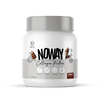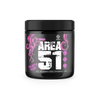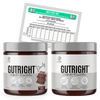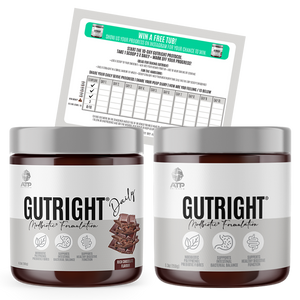Collagen Types – What’s up with them?

“What type of collagen does ATP use in their Noway range?”
This is probably one of the most popular questions we get through our channels from consumers and potential users of the future. With good reason too, consumers interested in the health and wellness space are becoming:
- Highly educated on the quality of the products they choose to put in their body.
- Are looking long-term and into the future, from a longevity perspective more nowadays.
They have good reason to be, the health and wellness industry is becoming more and more crowded with more 'marketing' brands out there jumping on the back of trends all just to make a quick buck. At ATP we understand the importance of knowing exactly what is in the product you are buying or interested in buying and where the ingredient is sourced from. We hope our outline below on the different types of Collagen can help you to make a better, more informed decision when you go to buy your next collagen product.
What is Collagen?
Collagen is the most abundant protein in the body and is a major insoluble fibrous protein in the matrix of all of our connective tissue structures in the body. At current, there are 16 known types of collagen present in the body, however, percentage-wise 80-90% of all of our bodies collagen is made up of the three main types and are types I, II, and III.[1]
The formation of these types of collagen with the exclusion of type IV looks like the structure of a springy triple helix strand designed to help our tissues withstand the stretching force put on them day-to-day (example pictured above in header image). The triple helix structure that comprises collagen protein is developed from three main corresponding amino acids:
- Glycine.
- Proline.
- Hydroxyproline.
Of course, helpful cofactors from our micronutrients in our diets like that of copper and vitamin C help in the assembly and cross-linking of new collagen to existing collagen fibrils. So, in an overview, collagen is our essential element for movement – from the fascia that encases our muscles to ensure they can glide across one another in smooth movement right down to how freely we can jump up and down on our joints and everything that requires stretching and moving motion in between. But, why are there different types?
Type I Collagen
The different types of collagen form due to specific requirements in the body – there is not always one key that universally unlocks every lock in the body. Having slightly different functions to a protein like that of collagen allows the body to change its structure outcome slightly depending on the need of it, after all, a large proportion of total body protein is from collagen.
With that in mind, let's have a look at type I collagen; Type I collagen is found abundantly in the human body. Dietary sources of bovine and marine collagen also contain type I collagen forms. Although interestingly, marine collagen is limited to type I only and not inclusive of type II and type III. The role of type I collagen is predominantly in bone and osteogenesis and is more of a stiffer structured collagen form capable of lasting the compressibility of day-to-day life like that on our tougher rigid structures like joints for example.[2]
Type I is also involved in cell-matrix signaling pathways and extracellular health.[3] Think of your scaffolding type structures that need to be a bit tougher, everything gets built into and around, bone, skin aspects, tendons, and blood vessels, and some aspects of muscle, etc. Your “performing under pressure” structures.[4]
Type II Collagen
There is some crossover in type II collagen with type I around its function for joints and cartilage in the body with regards to these stiffer structure types. Type II however tends to be cartilage-specific. Fun fact; the other rare small % forms of collagen that make up the other types of collagen outside the major three, like that of IX and XI also assist with this cartilage formation. For the most part, the role of type II is more specific to cartilage.[5]
Interestingly, if you are supplementing with this type of collagen peptide; you are best to take this at a different time to type I and type III. Why? It is said they actually compete for absorption with these other types and you may miss out on type II benefits, however, we have been unable to find a specific reference to ensure this was true. If you are taking all three forms in a day it may just be of convenience to separate them across the day. In saying that, the amino acids from type I and type III can help to form type II in the body, much the same as dietary consumption of foods high in these specific amino acid types and their co-factors.
Type III Collagen
Type III collagen function is very interesting – it is found more in vessels and hollow organs of the body. It is also involved in the critical element of wound healing and the interaction of blood platelets in the survival capability of blood clotting in animals and humans. The tissues that must withstand stretching and contraction like that of the uterus and the bowel are two major areas where type III collagen is required in the body.[6]
Type I and III often can occur together in the same collagen fibril structures and type III has also been found to support close proximity of type II in and around the cartilage aspects of the body. Type III also works on the endomysium and epimysium of our muscle make-up, so the white aspects surrounding the muscle fiber bundles internally as well as externally in the muscle. That combined with its integral function in cellular health in terms of cell adhesion, migration, and how well receptors function on the surface of the cell, it's a very important form of collagen that our body uses.[6]
Fun fact – one of the first ways that they discovered that type III collagen's role in the body was in wound healing and clotting, was through post-surgery wound fluids. They found that levels of type III collagen increased 2-3 days post-surgery and at day five were 1000-fold higher than those levels of non-surgical patients.[7]
Which type of Collagen is for me?
Well, if you’re human, ideally you should be accessing and building all forms of these collagen types, unless you are a fish of course maybe type I is more your style. So, the answer here is you should be consuming the amino acids and co-factors required to help build these collagen structures in the body.
To hear from a collagen expert who spends her whole day discussing the science of collagen, we recommend checking out the recent interview with feature guest Susan Lesner where the team broke down all frequently asked questions on collagen and their long history of research behind collagen peptides.
References:
- Lodish H, Berk A, Zipursky SL, et al. Molecular Cell Biology. 4th edition. New York: W. H. Freeman; 2000. Section 22.3, Collagen: The Fibrous Proteins of the Matrix. Available from: https://www.ncbi.nlm.nih.gov/books/NBK21582/
- Bolke, L., Schlippe, G., Gerß, J., & Voss, W. (2019). A Collagen Supplement Improves Skin Hydration, Elasticity, Roughness, and Density: Results of a Randomized, Placebo-Controlled, Blind Study. Nutrients, 11(10), 2494. https://doi.org/10.3390/nu11102494
- Trojanowska M, LeRoy EC, Eckes B, Krieg T. Pathogenesis of fibrosis: type 1 collagen and the skin. J Mol Med (Berl). 1998 Mar;76(3-4):266-74. doi: 10.1007/s001090050216. PMID: 9535560.
- https://www.sciencedirect.com/topics/biochemistry-genetics-and-molecular-biology/type-i-collagen
- Eyre DR. The collagens of articular cartilage. Semin Arthritis Rheum. 1991 Dec;21(3 Suppl 2):2-11. doi: 10.1016/0049-0172(91)90035-x. PMID: 1796302.
- Kuivaniemi, H., & Tromp, G. (2019). Type III collagen (COL3A1): Gene and protein structure, tissue distribution, and associated diseases. Gene, 707, 151–171. https://doi.org/10.1016/j.gene.2019.05.003
- Haukipuro K, Risteli L, Kairaluoma MI and Risteli J, 1987. Aminoterminal propeptide of type III procollagen in healing wounds in humans. Ann Surg206, 752–6.








